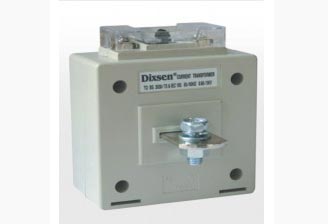
How are current transformers connected?
Sep 19,2024
Current transformers (CTs) are typically connected in series with the circuit being measured. Here's a more detailed explanation of how current transformers are connected:
1. Primary Side Connection:
- The primary winding of the CT is connected in series with the main current-carrying conductor.
- This conductor passes through the center of the CT or is wrapped around its core.
- The primary side usually has very few turns, often just one turn (the conductor passing through).
2. Secondary Side Connection:
- The secondary winding has many more turns and is connected to the measuring or protective devices.
- It's typically connected to ammeters, relays, or other instruments.
- The secondary circuit must always be closed when the primary is energized. An open secondary can lead to dangerously high voltages.
3. Grounding:
- One side of the secondary winding is usually grounded for safety reasons.
- The devices connected to the secondary are collectively called the "burden."
- The burden must be matched to the CT's rated burden for accurate measurements.
5. Polarity:
- CTs have polarity markings (H1, H2 on primary; X1, X2 on secondary).
- Correct polarity must be observed for proper operation, especially in protection schemes.
6. Multiple CTs:
- In three-phase systems, three CTs are often used, one for each phase.
- They can be connected in various configurations depending on the application (e.g., star, delta).
7. Shorting Blocks:
- Often, shorting blocks or test blocks are installed in the secondary circuit.
- These allow for safe disconnection of instruments or insertion of test equipment.
8. Ratio:
- The CT's ratio determines how much the primary current is stepped down.
- For example, a 100:5 CT will produce 5 amperes in the secondary when 100 amperes flow in the primary.
When installing or working with CTs, it's crucial to follow proper safety procedures, as opening a CT's secondary circuit while current flows in the primary can be extremely dangerous.
Prev News:Why is CT ratio 1 or 5?
Next News:What are the three types of current transformers?
1. Primary Side Connection:
- The primary winding of the CT is connected in series with the main current-carrying conductor.
- This conductor passes through the center of the CT or is wrapped around its core.
- The primary side usually has very few turns, often just one turn (the conductor passing through).
2. Secondary Side Connection:
- The secondary winding has many more turns and is connected to the measuring or protective devices.
- It's typically connected to ammeters, relays, or other instruments.
- The secondary circuit must always be closed when the primary is energized. An open secondary can lead to dangerously high voltages.
3. Grounding:
- One side of the secondary winding is usually grounded for safety reasons.
- This helps protect against high voltages that could develop if the primary insulation fails.
- The devices connected to the secondary are collectively called the "burden."
- The burden must be matched to the CT's rated burden for accurate measurements.
5. Polarity:
- CTs have polarity markings (H1, H2 on primary; X1, X2 on secondary).
- Correct polarity must be observed for proper operation, especially in protection schemes.
6. Multiple CTs:
- In three-phase systems, three CTs are often used, one for each phase.
- They can be connected in various configurations depending on the application (e.g., star, delta).
7. Shorting Blocks:
- Often, shorting blocks or test blocks are installed in the secondary circuit.
- These allow for safe disconnection of instruments or insertion of test equipment.
8. Ratio:
- The CT's ratio determines how much the primary current is stepped down.
- For example, a 100:5 CT will produce 5 amperes in the secondary when 100 amperes flow in the primary.
When installing or working with CTs, it's crucial to follow proper safety procedures, as opening a CT's secondary circuit while current flows in the primary can be extremely dangerous.

